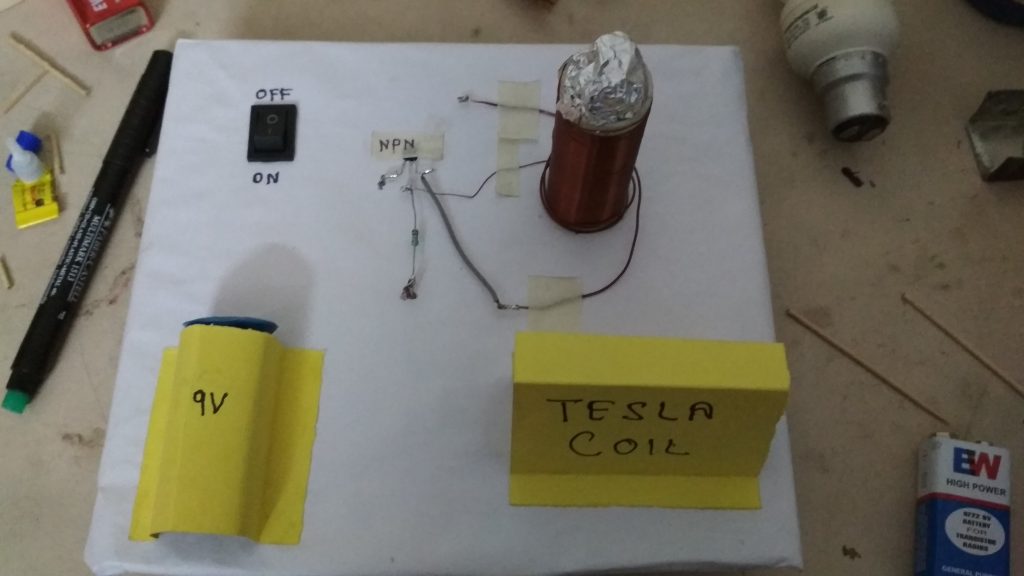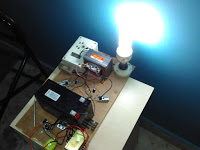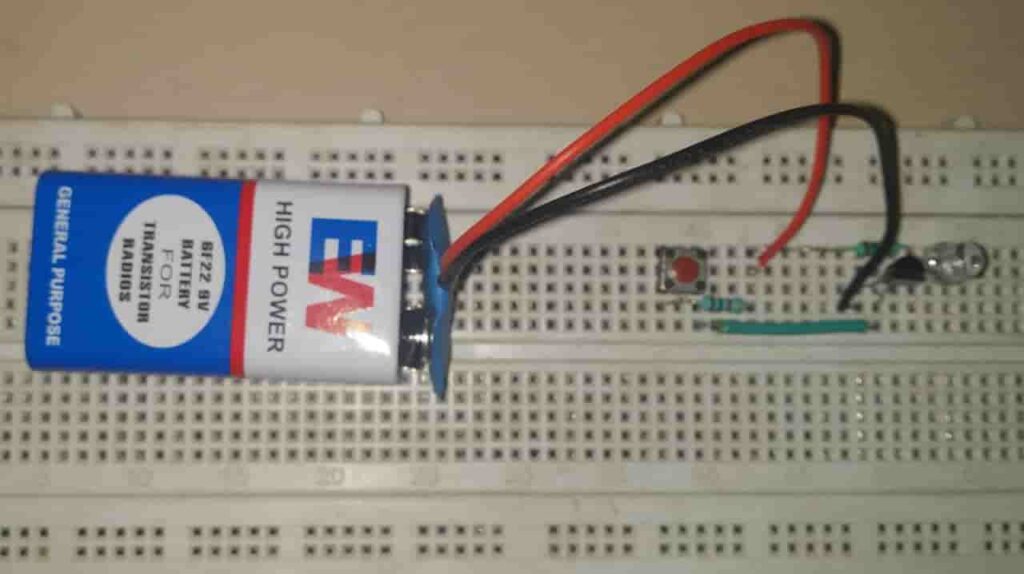Are you an ECE( Electronics Engineering) student? Are you an Electronics enthusiast or hobbyist who has just started? Do you want to learn some basics of electronics circuits and projects by some practical circuits? This article is for the students, newcomers, and electronics beginners who want to, or have just started with some practical electronics circuits and projects. Here I am going to discuss some of the most basic Top 10 electronics mini projects for beginners. So let’s begin with our Top 10 Electronics mini Projects.
These electronics mini circuit ideas can help anyone beginning with electronics to build up a very good concept and practice in building electronics circuits. Also, knowledge of how different electronics components work.
Top 10 Electronics Mini Projects Ideas for beginners
#1. Simple Transistor as a switch Circuit, powering an LED
Using a transistor as a switch, this configuration is a very popular, easy, and important mini project that many beginners try as their first project when learning about how to use transistors. In the world of electronics, this configuration of using a transistor as a switch is very important and helpful in the further building of circuits.
It simply involves putting together a basic NPN/ PNP transistor, resistor, power supply, and load together. When you throw the switch, you’ll get to see the LED( or any load, like a relay) turn on.
A simple circuit is here below and a list of projects using a single transistor is here.
WORKING OF TRANSISTOR AS A SWITCH CIRCUIT.
It might sound very simple, but it is an important concept for a good foundation in electronics. In the circuit above, I have used a BC547 BJT transistor, which is an NPN. A normal 5v DC supply, resistor, and an LED(as a load).
To turn the circuit ON, we need to give the transistor’s base a constant Logic 1(Positive). I have used a 5v DC source for that, you can use your 9V battery make sure to add a 10 ohms resistor between the LED’s anode and battery positive.
CUT-OFF Region
When the switch is open(off) the base of the transistor is not getting any supply, the transistor is Cut-Off state.
In the Cut-Off region, the operating conditions of the transistor are zero input current ( IB ), zero output collector current ( IC ), and maximum collector voltage ( VCE ) which results in the formation of a large depletion layer and no current flowing through the device.
So, LED will not Glow as transistor is OFF.
Saturation
When the switch is closed (Turn ON) then the transistor’s base is now high (Logic 1, Positive supply). Now, the transistor is getting enough biased, that the maximum amount of base current is applied, resulting in maximum collector current is causing a decrease in minimum collector-emitter voltage drop, this makes the depletion layer very thin as allowing the maximum current flowing through the transistor.
Now, the Transistor is in ON state.
#2. Build a Battery Charger Circuit
Now that you have understood how to use a transistor as a switch and have some basic understading, let’s move on.
There are many different ways that battery chargers can be built. Also, there are different battery types and for them, we use different battery chargers. Some of these projects just have a single transistor as a controller while others use more sophisticated circuitry using ICs and Microcontrollers, etc.
Usually, the power supply is basically a step-down transformer according to the specific requirements. The components for these projects are widely available and not terribly expensive. Follow here for a Simple Automatic Battery Charger.
#3. Build an Emergency Light Circuit that Switches, Auto turns on during electricity outage
After the automatic battery charger, now let’s move to a bigger circuit having more transistors and components. An automatic Emergency lamp or Automatic emergency light is an essential must-have gadget for those who are not having inverters in their home or are in the village are. They are also essential while camping, etc. An automatic emergency lamp is a very nice project that can help in developing more better concepts for practical circuits and electronics components working. An Automatic emergency light circuit is here click.
#4. Build an Automatic Night Light Circuit
An Automatic Night light circuit or Automatic Night lamp circuit is easier and uses fewer components. Now after you have come this far you might already have got a good understanding of transistors and other components. Now in this, you’ll get to know about how to make an automated night light and how to use LDR(Light Dependent Circuit). Here is a simple circuit for that. Automatic Night Light using LDR and Relay.
#5. Build a Fire Alarm Circuit that makes a Sound when Smoke is Detected
A smoke detector circuit is actually not a terribly complicated electrical circuit. Using integrated circuits, transistors, resistors, variable resistors, and other basic components, it’s very easy to construct a smoke detector that is fully functional and that plays a noise as loud as the loudspeaker hooked to the device permits when smoke is detected. Here is a simple smoke detector circuit.
#6. Making a simple Tesla Coil circuit

Making a mini tesla coil circuit and playing with it can be really fun. Tesla coil is like an air core electrical resonant transformer invented by the Great Nikola Tesla. It was to produce a high voltage low current high-frequency AC electricity. It was invented for Tesla’s dream of wireless and free electricity. Here we are not going to make that big setup but a mini Tesla Coil that really works and is fun. Here is a Mini Tesla Coil Circuit.
#7. LED Blinker Circuits, Using IC 555 and another by using transistor AMV
Now it’s time to use IC555 circuits, making an LED Blinker/ Flasher Circuit using IC555 is very easy and can be fun too. These kinds of circuits are built by just an IC555 in astable mode and some passive components to tune the frequency. For understanding that you can refer to here. There are two circuits. One using an IC555 timer and the other one using the transistor AMV setup.
Also, check the IC55 Delay. timer.
#8. Making a 12v DC to AC 220V Inverter Circuit, 3 different Circuits.

Inverter Circuits are something very cool. When you make your first inverter and that feeling is awesome. Here I am suggesting you first try to make a Simple Inverter using a transistor Astable Multivibrator circuit and MOSFETs with a Step-up transformer. With this, you’ll learn a lot about power, voltage, current, how inverters work, Mosfets and transformer types, and how to play with them. Then also move on to the IC555 100watt Inverter Circuit and IC CD 4047 Inverter Circuit. All of these are very well explained.
Also Check How do Inverters Work? Types. Design.
#9. Simple Wireless Power Transfer circuit
This one is also a very basic mini circuit but good for learning and developing the concepts involving Induction and wireless power transmission between two coils. Click here.
#10. IC555 PWM DC motor Electric Speed Controller
After so many circuits and going through these many projects now you know many things. Let’s move on to a PWM Controlled IC555 DC motor Speed controller. Here is a 100Watts PWM DC motor Speed controller.
#11. SMART automatic washbasin Tap Controller
A smart automatic washbasin Tap controller circuit is also easy and will make understand how an IR Proximity Sensor works. Also how an automatic hand-wash or Tap works. Here is a Smart Automatic washbasin Tap controller.
These were some easy but fun projects. After you try all these, now you’re having good knowledge about different electronics projects and Components. Also, you know how different components and Sensors Work.
So I hope you have liked this. And also hope that it will be helpful. If you guys liked it, do tell me in the comments. Also, subscribe to our Newsletter.
Thank You.





Awesome Tutorials on various project
nice
I’m not that much of a internet reader to be honest but your sites really nice.
I think I learned more from this post.
very nice put up, i definitely love this website, carry on it
Great gonna try all as I am new to this sir
There is definately a lot to find out about this subject. I really like all the points you have made.
Hi, I want to subscribe for this web site to get hottest updates, thus where can i do it please assist. Sibby Lion Boggs
Hello, thanks for visiting, Pop-up comes when you navigate through the website.
Cool, you covered most of things
thanks for visiting
Nice write-up and good suggestions for my students. Nice